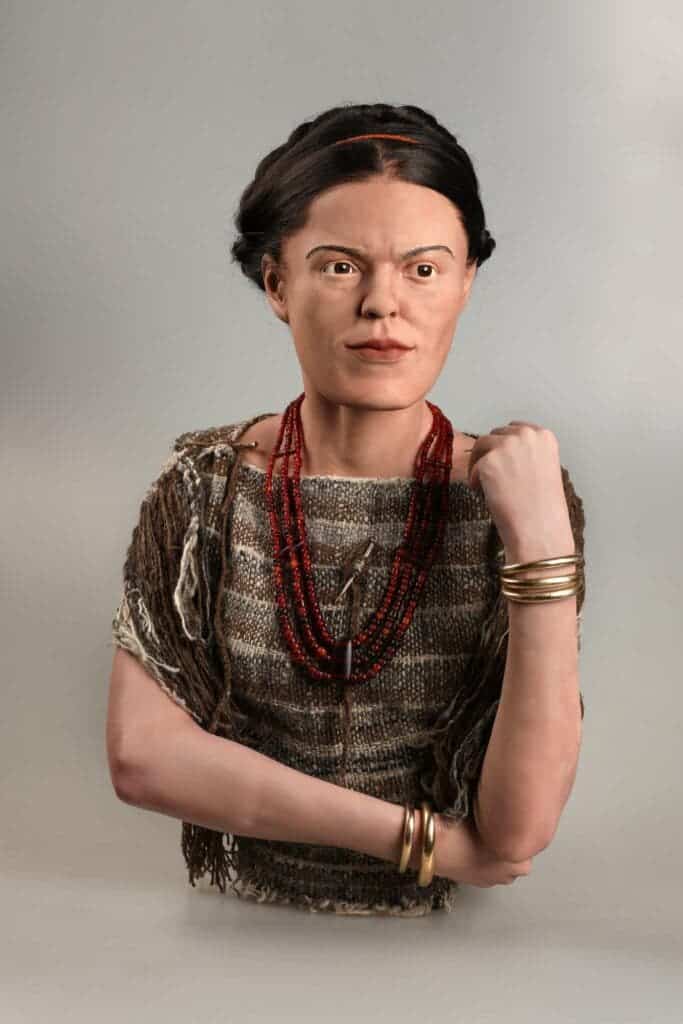Researchers at the Academy of Sciences of the Czech Republic want to show us what people in the Bronze Age looked like, by recreating the features of a wealthy, dark-haired woman of good economic standing of the time.

Were our ancestors, those who lived hundreds or thousands of years ago, that much different from us? Archaeologists have been going to great lengths to answer this question ever since the inception of this field of science. Modern techniques and the progressive discovery of more evidence are allowing them to inch ever closer to that answer.
Judging from the work of researchers at the Institute of Archeology of the Academy of Sciences of the Czech Republic, the answer seems to be that they were not very much different from us. This is based on the reconstruction of a Bronze-Age woman unearthed in a tomb in Bohemia — and judging by her burial goods, she was quite a wealthy individual.
Richly departed
The woman’s earthly remains were recovered at a site near the village of Mikulovice in the northern Czech Republic. Radiocarbon dating shows that she lived between 1880 B.C. and 1750 B.C. Prior to World War I, this area was part of the kingdom of Bohemia, and it is still known by this name.
The woman in question was found alongside 5 bronze bracelets, 2 gold earrings, a three-stranded necklace of amber consisting of more than 400 beads, and 3 bronze sewing needles. The wealth of burial goods clearly shows that she was very well-off for the period, with archeologists involved in her reconstruction remarking that she is very likely the wealthiest ancient woman ever discovered in the region or the Únětice culture. Despite her financial position, it is unclear who this woman actually was.
The Únětice culture were inhabitants of Central Europe in the Bronze Age and are well-known for their metal artefacts such as axe heads, daggers, bracelets, and torcs — necklaces made from twisted bands of metal.
Her discovery was part of a larger trove of 27 graves in the cemetery, and together, they formed an impressive haul of artifacts numbering close to 900 amber fragments. Around 40% of all female graves among this group had amber as part of their burial goods, and archaeologists at the academy were stunned to see the sheer wealth of it at the site. They explain that more amber goods were recovered from this site than in all of the Únětic graves in Germany combined.
All the amber here was likely sourced from the Baltic region, showcasing the widespread trade networks that formed in Europe at the time. The bronze artifacts also point to a high level of trade integration; although bronze artifacts have been found throughout the continent, the raw materials that went into producing this alloy — copper and tin — were quite rare and only produced in a few regions.
The woman that the team chose to recreate had the best-preserved skull out of any of the individuals buried at the site. Due to the excellent state of her remains, the team was able to isolate DNA samples, based on which they recreated features such as her (light) skin color and (brown) eyes and hair. Czech sculptor Ondřej Bílek helped with the reconstruction of the woman’s upper torso and head. The clothing and accessories the team adorned this recreation with were based on historical data, as well. The woman’s recreated clothing and accessories were based in science, as well. Ludmila Barčáková of the Institute of Archaeology of the Academy of Sciences made the amber necklace and gold earrings, metalworker Radek Lukůvka recreated the bronze bracelets and needles, and Kristýna Urbanová, an archaeologist specializing in textiles, fashioned the clothing.
Now, the team is hard at work establishing if there were any familial ties between other individuals whose DNA was recoverable at the site.
One exciting element of this research is that it helps us better understand regional differences in the cultures of Bronze Age Central Europe. In regions bordering Bohemia, the team explains, all wealthy graves that have been discovered belonged to men. It is yet unclear if women had a different status in the region bordering the graveyard at Mikulovice, allowing them to be burried with rich offerings, or if other cultural factors were at play.









